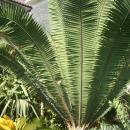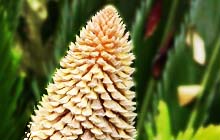Apa itu tanaman Sikas ?
“Tanaman Sikas atau nama latinnya Familia Cycadaceae, merupakan tanaman hias yang bentuk daunnya yang menyerupai bulu dan tumbuh mengarah ke luar dari batang. Warna daunnya yang hijau gelap tapi mengkilap membuat tanaman ini mudah dikenali dan digemari oleh pecinta tanaman di seluruh dunia.”
Informasi Selengkapnya »Sikas Market..
 Zamia Furfuracea Variegata merupakan mutasi genetik dari Zamia
Furfuracea yang banyak didapat di Indonesia. Tanaman ini berasal dari
Amerika Selatan.
Zamia Furfuracea Variegata merupakan mutasi genetik dari Zamia
Furfuracea yang banyak didapat di Indonesia. Tanaman ini berasal dari
Amerika Selatan.
 Encephalartos
Trispinosus dicatat oleh E. lehmannii kemudian di tahun 1965, Dr R.A.
Dyer mengklasifikasi ulang jenis tanaman ini. Tanaman ini banyak
dijumpai di daerah Afrika Selatan.
Encephalartos
Trispinosus dicatat oleh E. lehmannii kemudian di tahun 1965, Dr R.A.
Dyer mengklasifikasi ulang jenis tanaman ini. Tanaman ini banyak
dijumpai di daerah Afrika Selatan.
 Dioon
mejiae pertama kali diteliti dan dicatat oleh Dr. Isidoro Meijia.
Tanaman Ence yang satu ini begitu luar biasa. Tanaman ini dapat
bertahan pada suhu -5 C
Dioon
mejiae pertama kali diteliti dan dicatat oleh Dr. Isidoro Meijia.
Tanaman Ence yang satu ini begitu luar biasa. Tanaman ini dapat
bertahan pada suhu -5 C
Sikas In Action..
Encephalartos Munchii banyak ditemukan di negara Zimbabwe-Mozambique. Encephalartos Munchii dicatat oleh R. Allen Dyer and Inez Verdoon pada tahun 1969. Batang E. Munchii tingginya mencapai 1 meter.
Encephalartos ferox termasuk cukup populer dikalangan pecinta tanaman hias dan turis. Tanaman ini banyak dijumpai di negara Mozambique. Di Afrika Selatan, tanaman ini tumbuh dengan bebas di padang rumput.
Encephalartos lehmanii sering dijuluki sebagai "blue" Encephalartos. Dibandingkan dengan tanaman Ence lainnya, tanaman ini memiliki daya tahan yang tinggi dan dapat tumbuh dengan cepat.
Encephalartos latifrons memiliki detail daun yang sangat indah. E. Latifrons terdapat diprovinsi Eastern Cape, Afrika Selatan. Hingga kini, jumlah dari E. Latifrons tidaklah banyak.
Encephalartos longifolius mungkin Sikas Ence pertama yang dicatat pada tahun 1772 oleh E.Caffer. Tangkai dari tanaman ini biasanya tegak/lurus. Tingginya dapat mencapai 4 meter lebih.
Testimonial..
Pertama kali saya melihat tanaman Encephalartos, saya langsung menyukainya. Bentuk daunnya yang khas ditambah lagi tantangan didalam menumbuhkan tanaman jenis ini membuat saya ingin sekali mengoleksi tanaman ini.
Cycads are an ancient group of seed plants with a crown of large compound leaves and a stout trunk. They are a minor component of the flora in tropical and subtropical regions today, but during the Jurassic Period, they were a common sight in many parts of the world. For this reason, the Jurassic is often referred to as the "Age of Cycads".
The cycads are a small group of plants with many unique features, an ancient origin and a very long history. Cycads are known to have lived in the Permian era, over 200 million years ago - even before the dinosaurs roamed the earth. Although once abundant across the globe, the cycads are now greatly reduced in both numbers and distribution. There are now about 250 species in 11 genera, compared to possibly 300,000 species of flowering plants, the group that now dominates the world vegetation. All cycads are tropical or subtropical and each genus has a restricted geographical range.
The very large divided leaves means that cycad plants resemble palms or tree-ferns in overall appearance. Cycads, however, differ greatly in almost all aspects of detailed structure and reproductive behaviour. Cycad plants are dioecious (i.e. male and female reproductive structures are borne on separate plants), and reproduction is by seeds, which are produced on open carpophylls or seed-bearing leaves. Although technically woody plants, unlike other woody plants, cycads possess a pachycaul stem. This is a thick, soft stem or trunk made up of mostly storage tissue with very little true wood. Within the trunk, leaf traces or veins leading to leaves arise at a point opposite the attachment of the leaf, and circle the trunk within the storage tissue. These are known as with girdling leaf traces, and occur in some ferns but no other seed plants. The coralloid roots of cycads are also characteristics not seen in other seed plants, and the cycads lack the axillary buds seen in other seed plants.
The living cycads (division Cycadophyta) include about 250 species, with 11 genera in 3 families. The cycads have been classified as "gymnosperms" in the past, although recent studies have shown that this is not a natural group, some members being closer to the flowering plants than to other "gymnosperms". The "gymnosperms" are all ancient seed plants, many now extinct, but with four major groups living today. These are the cycads (Cycadophyta), the Welwitschia group (Gnetophyta), the conifers (Pinophyta) and Ginkgo, the Maiden Hair Tree (Ginkgophyta). They are now regarded as quite separate and distinct classes of equivalent status to the flowering plants (Angiosperms or Magnoliophyta). Although the four groups of "gymnosperms" are very different from one another in appearance they all produce naked ovules in contrast to the flowering plants in which the ovules are enclosed in an ovary.
On here you find find info about : Cycad, Cycads, Bowenia, Ceratozamia, Chigua, Cycas, Dioon, Encephalartos, Lepidozamia, Macrozamia, Microcycas, Stangeria, Zamia , Bowenia spectabilis, Bowenia serrulata, Ceratozamia hildae, Ceratozamia robusta, Cycas beddomei, Cycas bifida, Cycas bougainvilleana, Cycas cairnsiana, Cycas circinalis, Cycas debaoensis, Cycas diannanensis, Cycas micholitzii, Cycas panzhihuaensis, Cycas nongnoochiae, Cycas ophiolitica, Cycas pectinata, Cycas petraea, Cycas sexseminifera, Cycas siamensis, Cycas taitungensis, Cycas thouarsii, Dioon califanoi, Dioon merolae, Dioon caputoi, Encephalartos aemulans, Encephalartos aplanatus, Encephalartos arenarius, Encephalartos barteri, Encephalartos caffer, Encephalartos cerinus, Encephalartos chimanimaniensis, Encephalartos concinnus, Encephalartos cupidus, Encephalartos cycadifolius, Encephalartos dolomiticus, Encephalartos dyerianus, Encephalartos eugene-maraisii, Encephalartos ferox, Encephalartos friderici-guilielmi, Encephalartos ghellinckii, Encephalartos gratus, Encephalartos heenanii, Encephalartos hildebrandtii, Encephalartos horridus, Encephalartos humilis, Encephalartos inopinus, Encephalartos kisambo, Encephalartos lanatus, Encephalartos latifrons, Encephalartos laurentianus, Encephalartos lehmannii, Encephalartos longifolius, Encephalartos macrostrobilus, Encephalartos manikensis, Encephalartos middelburgensis, Encephalartos msinganus, Encephalartos munchii, Encephalartos natalensis, Encephalartos ngoyanus, Encephalartos nubimontanus, Encephalartos paucidentatus, Encephalartos poggei, Encephalartos princeps, Encephalartos pterogonus, Encephalartos schaijesii, Encephalartos schmitzii, Encephalartos sclavoi, Encephalartos senticosus, Encephalartos septentrionalis, Encephalartos tegulaneus, Encephalartos transvenosus, Encephalartos trispinosus, Encephalartos turneri, Encephalartos umbeluziensis, Encephalartos villosus, Encephalartos whitelockii, Encephalartos woodii, Lepidozamia peroffskyana, Macrozamia moorei, Macrozamia mountperriensis, Stangeria eriopus, Zamia herrerae, Zamia ipetiensis, Zamia lacandona, Zamia loddigesii, Zamia manicata, Zamia montana, Zamia neurophyllidia, Zamia polymorpha, Zamia portoricensis, Zamia prasina, Zamia pseudoparasitica, Zamia pygmaea, Zamia roezlii, Zamia skinneri, Zamia soconuscensis, Zamia splendens, Zamia standleyi, Zamia variegata, Zamia vazquezii, Zamia wallisii.






